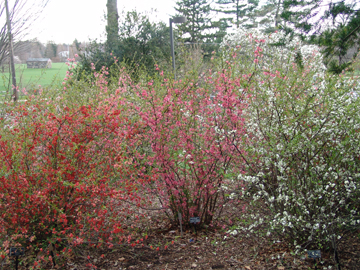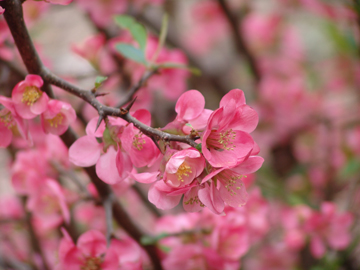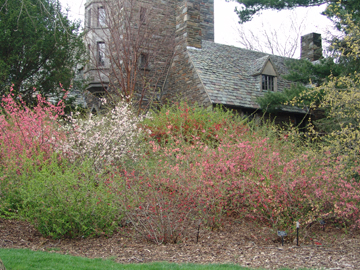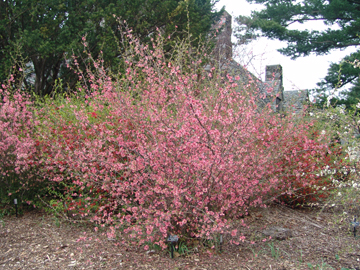Fleeting Beauties: The Flowering Quinces
Chaenomeles, or flowering quince, are a group of flowering shrubs that are almost in full-flower at the Scott Arboretum. The flowering quinces are one of those old-fashioned shrubs like lilac, hydrangea and spirea that are enjoying resurgence in popularity right now. Maybe the reason is that most of the plants in these groups are tough as nails, and to a new generation of home gardeners, they are “new” plants.
The types of flowering quinces mainly used in landscaping are from three groups: Chaenomeles speciosa (common flowering quince), C. japonica (Japanese flowering quince) and Chaenomeles x superba (a hybrid between C. speciosa and C. japonica). All of these are multi-stemmed shrubs forming a dense, twiggy mass of branches with occasional spines. Some selections have an upright growing habit while others have a more spreading habit. C. speciosa could grow to 6-10 feet high and wide; C. japonica to 2-3 feet high and wide; and the hybrid, C. x superba, is intermediate between the two at 4-5 feet high and wide. All species, and their numerous cultivars, flower in late March through April in white, red, scarlet, orange, peach or various shades of pink.
The Scott Arboretum has 24 different cultivars or species. The collection, just next to Bond parking lot and near the Benjamin West Visitor Center, has been flowering spectacularly the past two years. The collection had been neglected, but several hardy gardeners and Arboretum Assistants armed themselves with safety glasses, long-sleeves and long pants and performed major rejuvenation on the collection just after flowering. All of the old stems were cut to the ground, and the diameter of each plant was reduced so plants weren’t growing into each other. A few young, well-spaced stems were saved. It took just a few years for the plants to grow to the mature flowering beauties they are now. The annual maintenance will now consist of removing to the ground several of the oldest, tallest stems from each plant once flowering has finished.

From left: C. x superba 'Corallina', C. speciosa 'Nivalis', and C. x superba 'Fruticosa Alba' . photo credit: J. Jabco
While flowering quince is a one-season charmer, it is the perfect plant to grow clematis through for flowering in the summertime. Any clematis cultivar that ultimately would reach 6-10 feet long would be ideal in this situation.
Stop by and check out this wonderful flowering show, but do it soon. As with most spring plants, the show doesn’t last forever…..








kathy watts
Posted at 10:08h, 14 AprilThis shrub is one of my favorites. Thanks for featuring it, Jeff. To me it is not a “one season charmer” as I now have a great recipe for quince butter made from the fruit this shrub bears in the fall. The seeds and skin contain pectin so water and sugar is all you need. Of course, straining it is a bit labor intensive but the fruit of two bushes last year yielded 13 quarts of butter. Not only do I love eating it on bread for breakfast, I simmer a cup of it with rosemary and garlic for a sauce for pork roast. A jar of quince butter and roast pork recipe made for great holiday giving in 2008!
Jeff Jabco
Posted at 07:50h, 15 AprilAnd try “quince paste”. These are quince fruits cooked down with sugar to a condensed fruit candy. Traditionally called membrillo, it is eaten with Spanish manchego cheese.
Carla D'Anna
Posted at 23:03h, 29 AprilWhat quince is best for fruit and flowers? Is there a significant difference in the flowering quinces and the trees grown for fruit?
Chris Balducci
Posted at 17:30h, 29 SeptemberThe flowering quince is Chaenomeles. The fruiting quince is Cydonia. God bless.
Andrew Bunting
Posted at 10:21h, 04 OctoberMore insight from local plantsman Charles Cresson:
“The classic fruiting quince of Europe, and the best tasting with a delicate pear-like flavour, is Cydonia oblonga. Chinese quince, Pseudocydonia (or
whatever it is now) sinensis is less delicate and more pungent, but is also good for some things. Chaenomeles is really sour and kind of bitter, so not much eaten. All are hard and sour and require lots of sugar. The
popularity of European quince, declined with the development of pears. Same with the medlar and apples. Quince jelly is quite delicious.